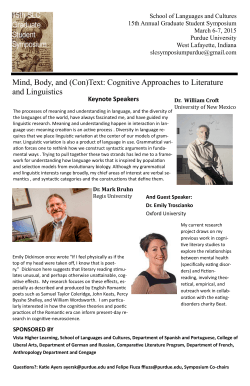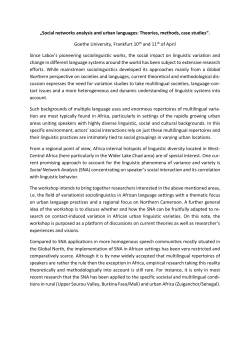
Linguistic Landscape 7 Workshop Program
Linguistic Landscape 7 Workshop Program Thursday, May 7-‐ Saturday, May 9 Dwinelle Hall, UC Berkeley Hosted by: Berkeley Language Center http://linguisticlandscape7.berkeley.edu THURSDAY, MAY 7 8:30 – 9:00 9:00 – 10:30 Breakfast Welcome & Plenary Speakers Susan Moffat (Global Urban Humanities Initiative, UC Berkeley), “Mapping the Landscapes of Disciplinary Languages: the Global Urban Humanities Initiative and the Study of Urban Space” Patricia Baquedano-‐López (Graduate School of Education and Center for Latino Policy Research, UC Berkeley), “Examining the Linguistic Landscape for Latinas/os in California: Resistance, Persistence, and Reinvention” Coffee Break 10:30 – 11:00 11:00 – 12:15 Concurrent Sessions #1 1A. Questioning Borders in the LL 1. Screti, “(Re)writing Galicia: Boundaries in imagined spaces” 2. Kallen, “Different borders, different landscapes: Linguistic Landscape and the Irish political border” 3. Gerst, Klessmann, & Korsun, “Multilingualism and linguistic demarcations in border regions: The ‘linguistic borderscape’ of the German-‐Polish twin cities Frankfurt (Oder)-‐ Słubice” 1B. Foundational questions, new directions: Language vitality in multilingual settings 1. Bhalla & Wiley, “Linguistic Landscape and language vitality: Investigating the Hindi communities in Northern Virginia” 2. Dubiner, “On identity and the LL of a Druze town in Israel” 3. De Costa & Rawal, “Landscaping a Midwestern Nepalese linguistic community from the inside” 1C. Expanding Methodologies in LL Studies 1. Barni, Bagna, & Machetti, “Historical and synchronic dimensions of LL in Italy: What methodologies are appropriate?” 2. Price, “One size fits all?: Method and madness in the LL” 3. Amos, “Living, working, belonging in the imagined ethnic zone: The linguistic landscape of Chinatown in Liverpool, UK” 12:15 – 1:45 1:45 – 3:00 Concurrent Sessions #2 2A. Then, now, and then: LL analyses across time 1. Blackwood, “Diachronic change in the contemporary LL: A return to Rennes and Perpignan” 2. Woldemariam, “Linguistic landscape as a standing historical testimony: The case of Ethiopia” 3. Vandenbroucke, “Displacing gentrification: A diachronic case-‐study of language and multilingualism in Brussels’ Quartier Dansaert” 3:00 – 3:15 3:15 – 4:30 Concurrent Sessions #3 4:30 – 4:45 4:45 – 5:30 Lunch Break 2B. Ideology and agency in multilingual schoolscapes 1. Przymus, “A Tale of Two Tuscons: The language of street signs and classroom instruction” 2. Szabó & Laihonen, “Where agency takes place: Schoolscapes in Finland and in Hungary” 3. Golden & Lanza, “Linguistic Landscape in a Norwegian Multilingual classroom of 2014/2014” 2C. Hearing the unspoken, seeing the unseen in the LL 1. Karlander, “Road signs revisited: Looking beyond inscription” 2. Hanauer, Hanauer & Heinemann, “Experiencing the Alloverstreet event: Arts-‐ based research on participatory linguistic landscapes” 3. Lou, Wong, & Wong, “Imagining place through linguistic landscape: Silent signs of resistance in Nga Tsin Wai Village, Hong Kong” Coffee Break 3A. Linguistic landscape and propaganda 1. Girvin, “Eastern-‐bloc propaganda signs and the problem of ‘authenticity’ 2. Zabrodskaja, “Kalevipoeg and Emelja on signs: Questioning cultural borders in Estonia” 3. Shohamy & Waksman, “Introducing a new municipal LL system in tourist areas of Tel Aviv-‐ Jaffa” 3B. Activating meaning-‐making in the LL: Literacy and language learning 1. Leymarie, Linguistic landscape in Clarkston, Georgia: Language, literacy, and refugee resettlement” 2. Bever & Richardson, “Defining linguistic landscapes as a tool for languages and literacy education” 3. Malinowski, “Juxtaposing spaces: A postmodern approach to language learning in the linguistic landscape” Transition to plenary Mini-‐plenary: Reflections on Practice 3C. Visibility and readership in new spaces 1. Soukup, “English in the linguistic landscape of Vienna, Austria (ELLVIA): Outline and rationale of a new project” 2. Legère, “SUV spare tire covers and Swahili in Dar es Salaam, Tanzania” 5:30 – 6:00 Transition to Dinner Cocktails & Dinner 6:00 – 9:00 FRIDAY, MAY 8 8:30 – 9:00 9:00 – 10:15 Breakfast Plenary Speakers Leanne Hinton (Department of Linguistics, UC Berkeley), “Languages on the Land: The linguistic ecology of California” Claire Kramsch (Department of German, UC Berkeley), “Theorizing LL: A return to u-‐topia?” 10:15 – 10:30 10:30 – 11:45 Concurrent Sessions #4 11:45 – 1:15 Coffee Break/Transition to concurrent sessions 4A. History and 4B. Reimagining Linguistic 4C. Online Linguistic memorialization in linguistic Landscape, from the ground up Landscapes landscape studies 1. Mac Giolla Chríost, “’Mind the 1. Ní Dhonnacha, Wade, & 1. Ben-‐Rafael & Ben-‐Rafael, gap’ – The linguistic Kallen, “Online linguistic “LL as symbolic landscape, the semiotic landscapes: Discourse, construction of the public landscape and language globalization, and space: Memorial in the display: Aims, methods and enregisterment” Bavarian Quarter” meaning” 2. Burdin, “Exploring the 2. Lanza & Røyneland, 2. Danielewicz-‐Betz, “Situational (virtual) linguistic landscape “Memorials, and temporal emplacement of of Kazimierz” multilingualism, and signs in (global) language 3. Troyer, “Online sites of multiculturalism in landscapes” engagement: A justification of Norway” 3. Steffensen & Johannessen, webspaces as linguistic 3. Guilat & Espinosa-‐Ramírez, “Linguistic landscapes as landscapes” “The Historical Memory ecological niches: A Law and its role in the re-‐ conceptual and design of the semiotic methodological cityscapes in Spain: The reconceptualization of LLS” Granada case study” Lunch Break 1:15 – 2:30 Concurrent Sessions #5 5A. Languages across spaces: Multiple si(gh)tings in LL research 1. Wolny, “Differentiation of the urban space: Linguistic diversity in the linguistic landscape of Venice” 2. Carr, “Comparing Koreatowns: The linguistic landscape of the K-‐Towns of Los Angeles & Mexico City” 3. Berezkina, “Multilingualism in progress?: A diachronic study of language policy in the virtual public space” 2:30 – 3:00 3:00 – 5:00 5B. Consuming signs and objects 1. Mc Laughlin, “Orienting the linguistic landscape: Ramadan advertising in Dakar” 2. Jaworski, “Language objects, art and consumer culture” 3. Baro, “Chronoscape of inner-‐ city Johannesburg: A semiotic landscape analysis of post-‐ apartheid urban development” 5C. Judging and contesting diversity in/through the LL 1. Stoicheva, “City multilingualism: Between bonds and barriers” 2. Niedt, “New neighbors: The evolution of attitudes towards a changing linguistic landscape in Philadelphia” 3. Sobkowiak, “Multilingual signs and endangered language revitalization efforts. Presence of written language in public spaces and language attitudes. Case of Nahuatl in Mexico” Coffee Break/Transition to Reflections on Practice 5:00 – 5:15 5:15 – 6:15 Reflections on Practice (Presenters and titles listed below. All Reflections on Practice to occur in this session) Transition to Plenary Plenary Session Re-‐Viewing our Work, and Designing New Futures: Report-‐Back on Reflections on Practice 8:00 – 8:30 8:30 – 9:45 Concurrent Sessions #6 SATURDAY, MAY 9 Breakfast 6A. Reading the past on the streets today: 6B. Protest and transformation History, heritage, archive 1. Anfinson, “The writing on the wall: The 1. Kailuweit, “A historical linguistic landscape – Umbrella Movement, language and revolution” Barcelona (1836-‐38): Much ado about the 2. Rubdy, “A multimodal analysis of the graffiti use of Catalan in public space” commemorating the 26/11 Mumbai terror 2. Ritchey, “Caught between heritage and attacks: Constructing self-‐understandings of a utility: Bilingual French-‐Occitan street senseless violence” names” 3. Curtin, “The semiotic landscape of Taiwan’s 3. Train, “Connecting visual presents to archival “Sunflower student movement’: Examining the pasts in multilingual California: Towards transbordering dynamics of situated linguistic historical depth in linguistic landscape” landscaping” 9:45 – 10:00 Coffee Break 10:00 – 11:15 Concurrent Sessions #7 7A. Landscapes of the flesh, body, and self 1. Peck & Stroud, “Skinscapes: Widening the LL lens to include racialized bodies-‐in-‐place” 2. Hanell, “Navigating the linguistic landscape: On the discursive encounters of a new parent” 3. Correa, Shohamy & Dominguez, “Expanding the research on commodification of women’s bodies: Internet sites as modes of delivery to local and transnational audiences” 11:15 – 12:00 12:00 – 12:45 7B. Struggles of gentrification, citizenship and representation in the LL 1. Kitis, “Imagining Johannesburg: Mapping place-‐ names and their collocates from a newspaper corpus 2. Tufi, “Linguistic landscapes of urban Italy and the citizenship of the everyday” 3. Lyons, “Signs of the times: Modeling the landscape of gentrification” Workshop summary Business meeting Reflections on Practice Friday, May 8, 3:00 – 5:00 p.m. Format: Multiple roundtable sessions with clusters of thematically-‐related papers Abraham, “Integrating the Linguistic Landscape in Technology-mediated Environments for Language Learning and Teaching” Adams & Linares, “Questioning Boundaries: Towards a Unified Framework of ‘(Virtual) Linguistic Landscapes’” Amos, “Quantitative 2.0: Re-evaluating the worth of empirical sign counts and introducing the 'big data' corpus” Blackwood, “Multilingualism and memorialization: starting the debate” Buckingham, “Linguistic landscapes and methodological issues/ political activism” Burton & Clark, “English as a street language: Teaching ESL with the linguistic landscape” Callahan, “Spanish in the linguistic landscape of museums in California and New York: A resource for heritage language learners and students of translation” Carr, “Reflecting on Koreatowns: The Linguistic Landscape of the K-Towns of Los Angeles & Mexico City” Choi & Lee, “’Seoul Korea, Mexico City, and Takorea.’ Geolocative Linguistic Landscape Project in University Korean Language Classes” Dubiner, “The challenging task of interviewing shop owners” Garvin, “Toward an ethical treatment of history in the LL: 'Post-memory' narratives in a southern American town” Hayashi-Takakura, “A sample of teaching Chinese characters (kanji) with linguistic landscape for heritage language learners of Japanese” Hernandez-Martin, “In a certain place in London. Cityscape in Spanish” Kallen, Dunlevy & Balaeva, “Contextualising units in the Linguistic Landscape- How should data be framed?” Karlander, “Mobility, emptiness, and the meaning of absence: integrating semiotic “blank spots” in the LL framework” Leung & Knitter, “Art and linguistic landscapes: A look at the Chinatowns of San Francisco and Washington D.C.” Lyons, “Quantifying the Linguistic Landscape – Reflections on Inferential Analyses” Maxim, “Raising methodological awareness among study abroad participants: Reflections from a student-driven linguistic landscape research project” Price, “Out With the Old, In With the New?: Not So Fast!” Ritchey, “The history of street names in southern France” Soukup, “The role of the ‘recipient’ in LL research: Notes from the project ‘English in the linguistic landscape of Vienna, Austria’ (ELLViA)” Szabó, “Reading, reconstructing and interpreting the linguistic landscape of schools: Working with the ‘tourist guide technique’” Woldemariam, “Methodological challenges in conducting LL research” Zabrodskaja, “Language representation on a sign”
© Copyright 2025









